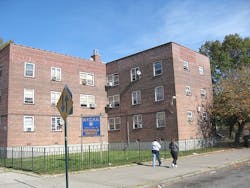Clean Heat Challenge targets more than $200M to incentivize innovative heat pump technologies for NYC Housing
A new competition promises to both challenge, and reward, heating and cooling equipment manufacturers which come up with innovations in multifamily housing electrification and energy efficiency tools.
The Clean Heat for All Challenge will utilize the New York City Housing Authority’s building portfolio to be early adopters of the best and workable new ideas for reducing greenhouse emissions from housing appliances, heating and air. The NYCHA is a partner in the initiative with the public utility New York Power Authority (NYPA) and the New York State Energy Research and Development Authority (NYSERDA).
The three entities will invest more than $263 million to advanced electrification solutions on the heating, ventilation and cooling (HVAC) side of the multifamily housing equation.
“Heating residential buildings through the use of fossil fuels is responsible for a massive amount of greenhouse emissions," said King County Housing Authority Executive Director Stephen Norman. “We applaud NYCHA’s leadership in developing new heat pump technology that will provide energy-efficient options for both heating and cooling. This is a crucial step in reducing the carbon footprint of public housing and holds tremendous promise for our nation’s inventory of over one million federally subsidized housing units.”
The NYCHA portfolio includes nearly 2,200 residential dwelling buildings.
The challenge calls upon manufacturers to develop a packaged cold climate heat pump that can be installed through an existing window opening to provide heating and cooling on a room-by-room basis. The envisioned product would enable rapid, low-cost electrification of multifamily buildings by reducing or eliminating many of the cost drivers inherent to existing heat pump technologies when used in resident occupied apartments.
These include costly electrical upgrades, long refrigerant pipe runs, drilling through walls and floors and other construction aspects which result in high project costs, and significant disruption to residents.
“New York state law mandates that we move away from fossil fuels and binds us to an aggressive, ambitious timeline for carbon neutrality,” said NYS Homes and Community Renewal Commissioner, RuthAnne Visnauskas. “I congratulate and thank Governor Hochul, NYSERDA, NYPA and NYCHA for taking us to this next step in the challenge to create clean retrofit technology that we can apply to all of our aging buildings. Our fight against the negative impact of climate change – and our future - depends upon partnerships like this one.”
About the Author
Rod Walton, EnergyTech Managing Editor
Managing Editor
For EnergyTech editorial inquiries, please contact Managing Editor Rod Walton at [email protected].
Rod Walton has spent 17 years covering the energy industry as a newspaper and trade journalist. He formerly was energy writer and business editor at the Tulsa World. Later, he spent six years covering the electricity power sector for Pennwell and Clarion Events. He joined Endeavor and EnergyTech in November 2021.
Walton earned his Bachelors degree in journalism from the University of Oklahoma. His career stops include the Moore American, Bartlesville Examiner-Enterprise, Wagoner Tribune and Tulsa World.
EnergyTech is focused on the mission critical and large-scale energy users and their sustainability and resiliency goals. These include the commercial and industrial sectors, as well as the military, universities, data centers and microgrids. The C&I sectors together account for close to 30 percent of greenhouse gas emissions in the U.S.
He was named Managing Editor for Microgrid Knowledge and EnergyTech starting July 1, 2023
Many large-scale energy users such as Fortune 500 companies, and mission-critical users such as military bases, universities, healthcare facilities, public safety and data centers, shifting their energy priorities to reach net-zero carbon goals within the coming decades. These include plans for renewable energy power purchase agreements, but also on-site resiliency projects such as microgrids, combined heat and power, rooftop solar, energy storage, digitalization and building efficiency upgrades.

